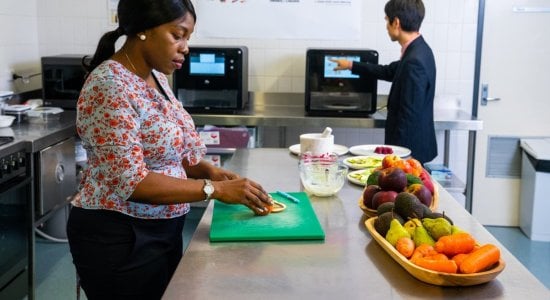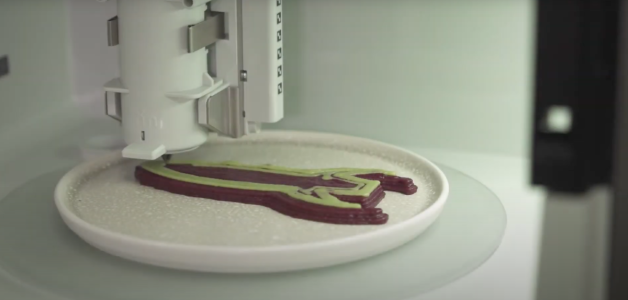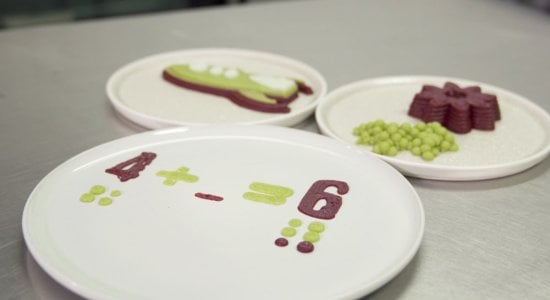Incredible breakthrough! See how researchers use 3D printing technology to prepare food for aged care residents
By
VanessaC
- Replies 29
For those suffering from malnutrition and experiencing difficulties while chewing and swallowing, the research team at Edith Cowan University has created a food revolution that will help aged care residents get proper nutrition.
Unveiled as the culinary revolution of 3D food printing, this project is created in partnership with aged care agency Brightwater Care Group, and produces one small meal packed with nutrients while also reducing food waste.
According to Chef Amanda Orchard from Edith Cowan University, their goal is to provide amazing flavour, nutrition, and joy in every single bite.
The meal itself may look small, but it’s full of ingredients like eggs, ricotta, feta, onions and garlic that are chopped, freeze-dried, and pureed into a creamy mash.
Catherine Stoddart, the CEO of Brightwater Care Group, notes that this cutting-edge technology allows elderly residents to enjoy nutrition-packed meals that are tailored to their needs.
'There are mixes of food that add additional protein, that add additional minerals and vitamins that people don't normally get,' Stoddart said.
What’s more, the twist of 3D printing technology enables researchers to make texture-modified meals more appealing for ageing appetites.
'We can provide them with high energy, long life, lightweight fruit, vegetables or other food products,' said Dr Liezhou Zhong from Edith Cowan University.
And while 3D-printed meals are currently only being served in aged care facilities, Dr Zhong is positive that this concept can expand to schools, the military, and even potentially the general public in the next 12 to 18 months.
As an added bonus, this project also uses produce that otherwise would be discarded due to their appearance.
'All we have done is try to create beautiful presentations, more nutritious food, and a more enjoyable dining experience for them to stimulate their appetite so they can eat more,' Dr Zhong said.
Benefits of 3D printed food for elderly and disabled individuals
The world of food tech is a fascinating field, and this latest application holds great promise for a demographic that sometimes gets overlooked–our senior citizens, especially those with disabilities.
One of the greatest benefits of this 3D printing marvel is its ability to customise the type of ingredients used and their proportions. This means that meals can be uniquely tailored to each individual's dietary needs. Older adults require a balanced blend of nutrients with appropriate portion sizes that their bodies can digest and absorb optimally. With the magic of 3D printing, even considerations like individual food intolerances or allergies can be factored in, creating a truly personalised and nutritious meal.
Moreover, the convenience factor is a game changer. Standard kitchen tasks, such as preparing, cooking, and even spooning out a meal, can pose a challenging task to seniors with motor issues or debilitating arthritis. With these 3D-printed meals, the preparation process becomes as simple as pressing a button. Over time, this aids in fostering independence and boosts morale among our older community members.
But the benefits extend even further. Those with dysphagia, or difficulty swallowing, often are limited to a diet of purees and soup, which can get monotonous after a while. 3D-printed food, with its carefully controlled textures and shapes, can potentially introduce a wider variety of meals and snacks to the menus of those with dysphagia. Plus, isn’t there just something delightful about biting into a spinach frittata 'cube' made of 3D-printed goodness? This revolution might just bring a little joy to meal times again!
All this is not just about convenience or nutrition. This incredible application of 3D printing is a holistic approach to health and well-being, promoting dignity, independence, and a bit more joy at the dinner table. Isn't that what we all want?
With 3D printing technology becoming more affordable and accessible, we can expect to see more impressive concepts like this one being developed in the near future. Here’s another 3D printing project that may be useful for all of us!
Have you seen similar projects or any other brilliant ideas used to help the elderly? We’d love to hear your stories in the comments section below!
Unveiled as the culinary revolution of 3D food printing, this project is created in partnership with aged care agency Brightwater Care Group, and produces one small meal packed with nutrients while also reducing food waste.
According to Chef Amanda Orchard from Edith Cowan University, their goal is to provide amazing flavour, nutrition, and joy in every single bite.
The meal itself may look small, but it’s full of ingredients like eggs, ricotta, feta, onions and garlic that are chopped, freeze-dried, and pureed into a creamy mash.
Catherine Stoddart, the CEO of Brightwater Care Group, notes that this cutting-edge technology allows elderly residents to enjoy nutrition-packed meals that are tailored to their needs.
'There are mixes of food that add additional protein, that add additional minerals and vitamins that people don't normally get,' Stoddart said.
What’s more, the twist of 3D printing technology enables researchers to make texture-modified meals more appealing for ageing appetites.
'We can provide them with high energy, long life, lightweight fruit, vegetables or other food products,' said Dr Liezhou Zhong from Edith Cowan University.
And while 3D-printed meals are currently only being served in aged care facilities, Dr Zhong is positive that this concept can expand to schools, the military, and even potentially the general public in the next 12 to 18 months.
As an added bonus, this project also uses produce that otherwise would be discarded due to their appearance.
'All we have done is try to create beautiful presentations, more nutritious food, and a more enjoyable dining experience for them to stimulate their appetite so they can eat more,' Dr Zhong said.
Benefits of 3D printed food for elderly and disabled individuals
The world of food tech is a fascinating field, and this latest application holds great promise for a demographic that sometimes gets overlooked–our senior citizens, especially those with disabilities.
One of the greatest benefits of this 3D printing marvel is its ability to customise the type of ingredients used and their proportions. This means that meals can be uniquely tailored to each individual's dietary needs. Older adults require a balanced blend of nutrients with appropriate portion sizes that their bodies can digest and absorb optimally. With the magic of 3D printing, even considerations like individual food intolerances or allergies can be factored in, creating a truly personalised and nutritious meal.
Moreover, the convenience factor is a game changer. Standard kitchen tasks, such as preparing, cooking, and even spooning out a meal, can pose a challenging task to seniors with motor issues or debilitating arthritis. With these 3D-printed meals, the preparation process becomes as simple as pressing a button. Over time, this aids in fostering independence and boosts morale among our older community members.
But the benefits extend even further. Those with dysphagia, or difficulty swallowing, often are limited to a diet of purees and soup, which can get monotonous after a while. 3D-printed food, with its carefully controlled textures and shapes, can potentially introduce a wider variety of meals and snacks to the menus of those with dysphagia. Plus, isn’t there just something delightful about biting into a spinach frittata 'cube' made of 3D-printed goodness? This revolution might just bring a little joy to meal times again!
All this is not just about convenience or nutrition. This incredible application of 3D printing is a holistic approach to health and well-being, promoting dignity, independence, and a bit more joy at the dinner table. Isn't that what we all want?
With 3D printing technology becoming more affordable and accessible, we can expect to see more impressive concepts like this one being developed in the near future. Here’s another 3D printing project that may be useful for all of us!
Have you seen similar projects or any other brilliant ideas used to help the elderly? We’d love to hear your stories in the comments section below!










